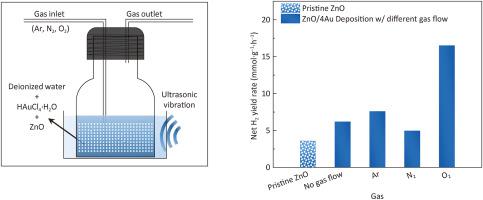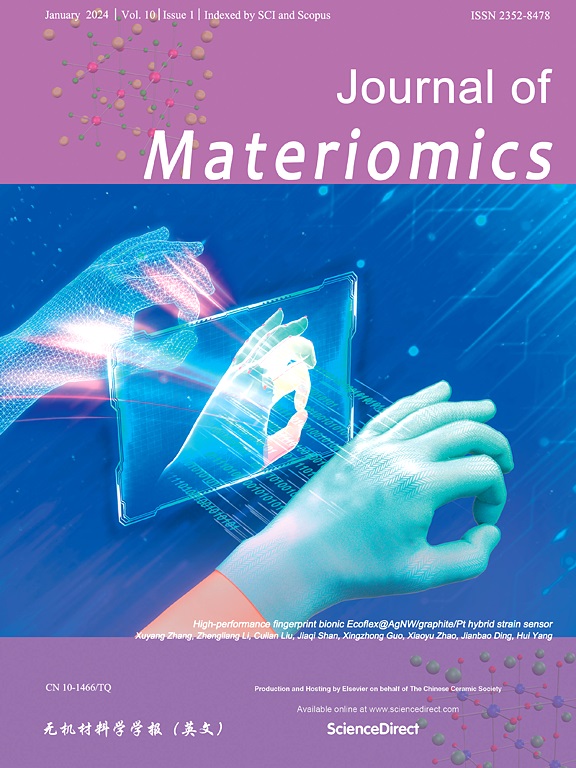Atmosphere-driven metal-support synergy in ZnO/Au catalysts for efficient piezo-catalytic hydrogen evolution
IF 8.4
1区 材料科学
Q1 CHEMISTRY, PHYSICAL
引用次数: 0
Abstract
Piezo-catalysis, which leverages mechanical energy to drive chemical reactions, is emerging as a promising method for sustainable energy production. While the enhancement of piezo-catalytic performance through metal-support interactions is well-documented, the critical influence of the synthesis atmosphere during metal-loaded piezo-catalyst preparation has been a notable gap in the field. To this end, we systematically investigate how different atmospheric conditions during the synthesis of catalysts—without gas flow or with Ar, N2 and O2—affect metal dispersion, oxidation states, piezo-carrier dynamics, and electronic structure, and subsequently shape the metal-support interactions and piezo-catalytic activity. ZnO/Au, with Au deposited on ZnO, is selected as the model system, and hydrogen evolution reaction is used as the probe reaction. Our results demonstrate that an oxygen-enriched atmosphere significantly enhances the metal-support interactions, achieving an ultrahigh net hydrogen yield of 16.5 mmol·g−1·h−1 on ZnO/Au, a 3.58-fold increase over pristine ZnO. Specifically, the performance improvements substantially surpass those synthesized under other atmospheric conditions. Conversely, exposure to CO2 transforms the ZnO support into ZnCO3, adversely affecting its catalytic activity. These findings reveal the crucial impact of synthesis conditions on piezo-catalyst performance and thereby open new avenues for optimizing catalyst systems for enhanced sustainability.


ZnO/Au 催化剂中大气驱动的金属-支撑协同作用促进高效压电催化氢气进化
压电催化利用机械能驱动化学反应,正在成为一种有前途的可持续能源生产方法。虽然通过金属与支撑物的相互作用提高压电催化性能已得到充分证实,但在金属负载压电催化剂制备过程中合成气氛的关键影响一直是该领域的一个显著空白。为此,我们系统地研究了催化剂合成过程中的不同气氛条件--无气流或有 Ar、N2 和 O2--如何影响金属分散、氧化态、压电载体动力学和电子结构,并进而影响金属-支撑相互作用和压电催化活性。我们选择金沉积在 ZnO 上的 ZnO/Au 作为模型体系,并以氢进化反应作为探针反应。我们的研究结果表明,富氧气氛显著增强了金属与支撑物之间的相互作用,在 ZnO/Au 上实现了 16.5 mmol-g-1-h-1 的超高净氢产率,是原始 ZnO 的 3.58 倍。具体而言,性能的提高大大超过了在其他大气条件下合成的产品。相反,暴露在二氧化碳中会使氧化锌支持物转化为 ZnCO3,从而对其催化活性产生不利影响。这些发现揭示了合成条件对压电催化剂性能的重要影响,从而为优化催化剂系统以提高可持续性开辟了新的途径。
本文章由计算机程序翻译,如有差异,请以英文原文为准。
求助全文
约1分钟内获得全文
求助全文
来源期刊

Journal of Materiomics
Materials Science-Metals and Alloys
CiteScore
14.30
自引率
6.40%
发文量
331
审稿时长
37 days
期刊介绍:
The Journal of Materiomics is a peer-reviewed open-access journal that aims to serve as a forum for the continuous dissemination of research within the field of materials science. It particularly emphasizes systematic studies on the relationships between composition, processing, structure, property, and performance of advanced materials. The journal is supported by the Chinese Ceramic Society and is indexed in SCIE and Scopus. It is commonly referred to as J Materiomics.
文献相关原料
公司名称
产品信息
阿拉丁
zinc acetate
阿拉丁
sodium hydroxide
阿拉丁
polyethylene glycol
阿拉丁
absolute ethanol
 求助内容:
求助内容: 应助结果提醒方式:
应助结果提醒方式:


